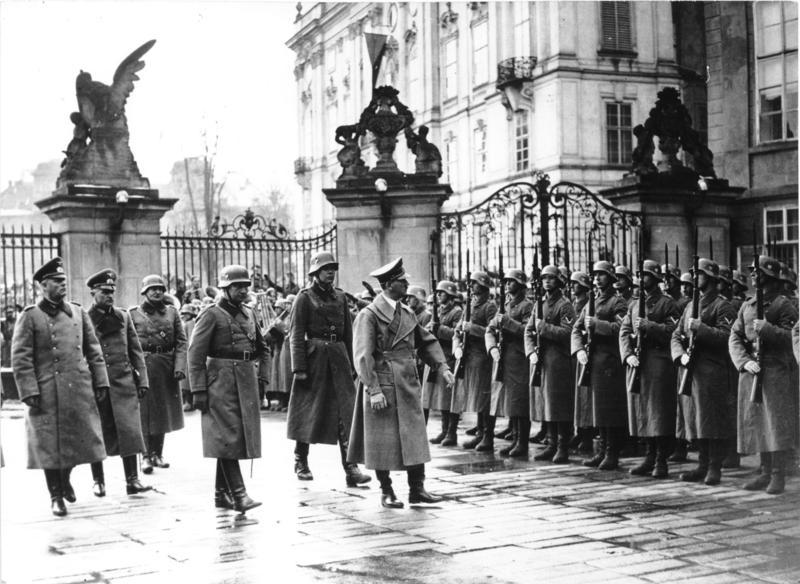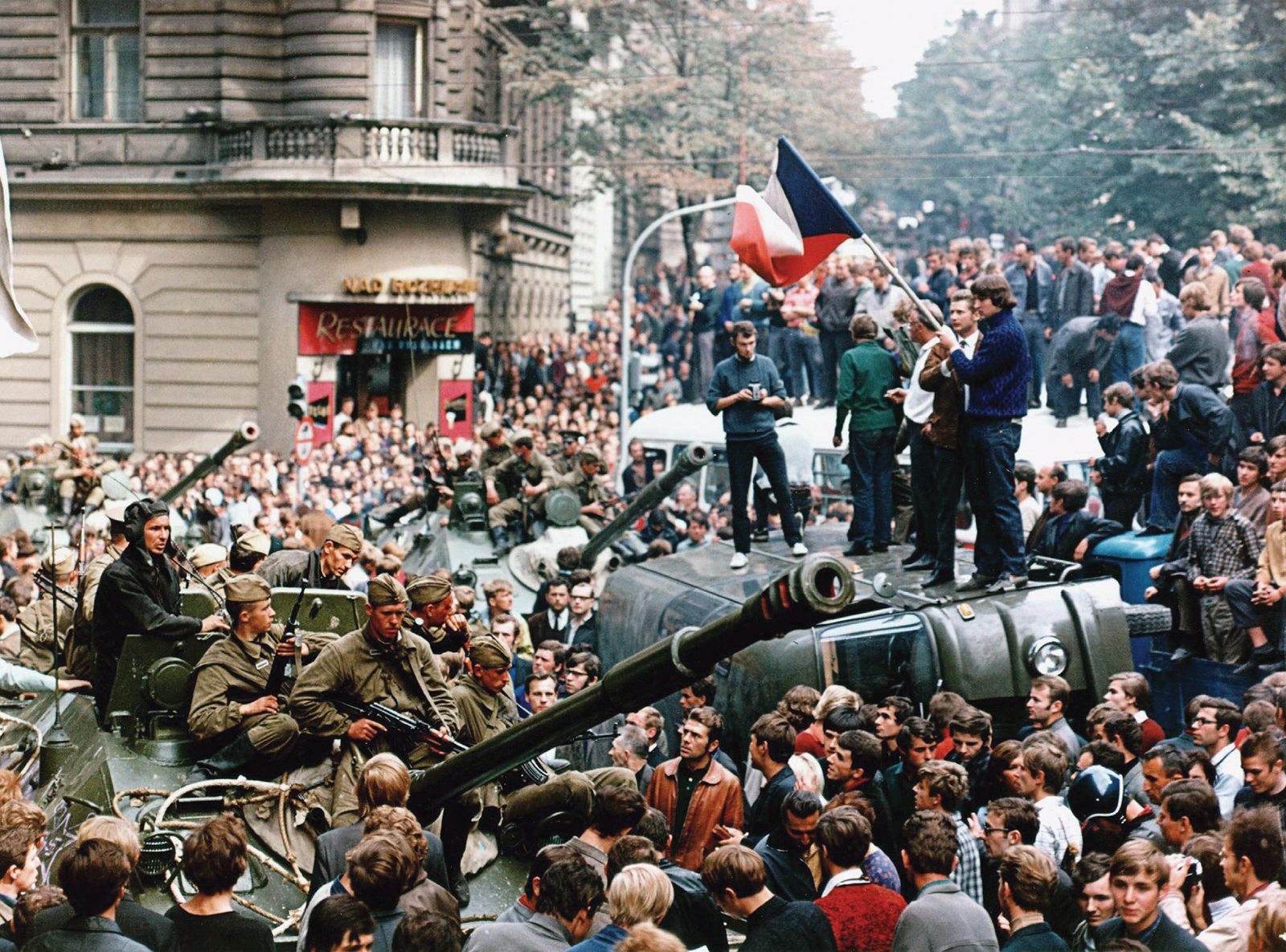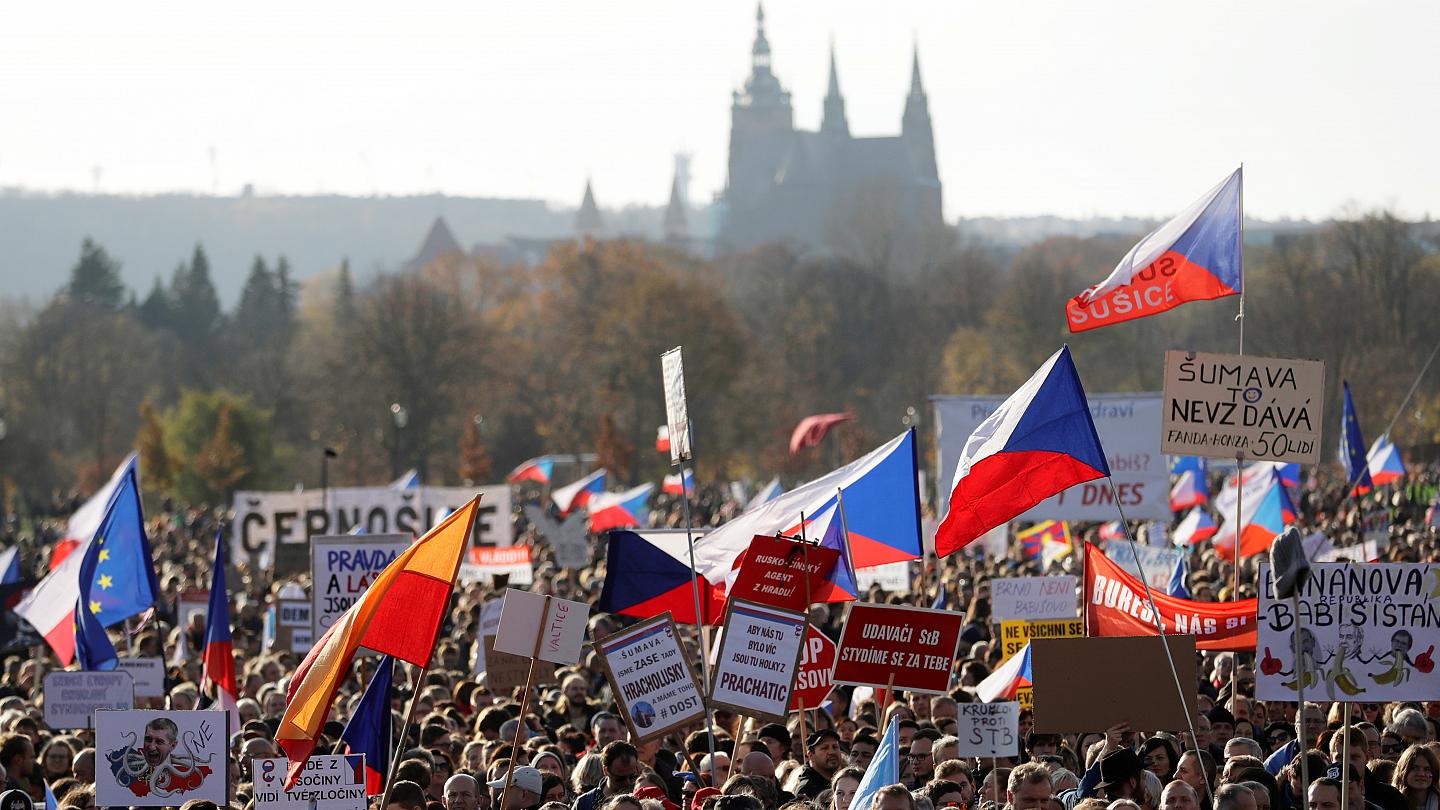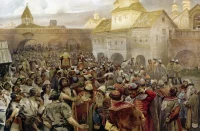WWII (1939−1945)
The decision of Slovaks during WWII to accept A. Hitler’s protectorate over quasi-independent Slovak state created one of the mutual grievances that existed between the Czechs and the Slovaks in the post-war decades. Due to fear of what the Third Reich would do to Slovakia if Czechoslovakia was defeated by Germany in the case of the war, Slovakia declared its quasi-independence and became a protectorate of Nazi Germany. However, that was not the extent of the Nazi impact on Slovakia. Instead, the Slovak nationalists adopted some of the Nazi sentiments. The President of Slovakia, Jozef Tiso, set up a quasi-Nazi state. The Czechs as well as the Jews were treated poorly by this new Government. The definition of what a Jew was also changed, from being a religious definition to now being an ethnic one. Such an antisemitic policy had several points. For one, it was felt to make it easier to separate Jews from the rest of the population. This definition also separated the Jews from the rest of the Slovaks ethnically and was used as justification for the poor treatment, and eventual deportation of the vast majority of Jews in Slovakia to the concentration and death camps, where the majority of them died. This included also children, whom J. Tiso believed should not be separated from their families, and so many of them went to the gas chambers with their mothers. Some Jews were not deported due to their importance in the economic functioning of the Government, but this did not protect them from poor treatment. There is some controversy about how much the Slovak Government actually adopted the tenants of Nazism, and whether this was due to pressure from the Nazi Government or whether or not the ideas were internalized by the Slovak political elite. Nevertheless, while the declaration of independence and protectorate status of Slovakia during WWII did create mutual grievances, it does not exist as a strong point of contention between the Slovaks and the Czechs today.
Following the murder of Reinhard Heydrich, the Nazi German rule of terror in the Czech lands climaxed in the revenge action of the destruction of the village of Lidice. R. Heydrich (1904−1942) was a German Nazi police general and one of the most ruthless Nazis. In 1934 he became chief of the Gestapo, before being promoted to chief of the internal security service by H. Himmler. R. Heydrich became appointed general of the police in 1941 and as such directly responsible for the execution of the policy of “Final Solution” of the Jewish Question in occupied Europe. In the same year, he became appointed Deputy Protector of Bohemia being assassinated in Prague by a Czech who was a British agent. In retaliation, Lidice, a Czech village, was destroyed by the SS and Gestapo on Jene 10th, 1942 when all-male inhabitants (160+) were shot, 192 women were deported to the concentration camp at Ravensbrück, where 52 of them died, and 96 children were deported to be Germanized in SS camps.

Nevertheless, although the Nazi German oppression and brutality have been severe, they remained at a level to be compared with the Nazi rule in occupied West Europe and is totally different in comparison with East and South-East Europe (for instance, the 1941 Kragujevac Massacre in Central Serbia compared with the Lidice case), and were not as brutal as in Poland or the occupied territories of the USSR. The reason for such practice partly was because of the Nazi reliance on the Czech labor force in the armament industry.
The transitional period (1945−1948)
At the end of the war, both Czechs and the Slovaks agreed to return to the pre-war arrangement of Czechoslovakia. After the war, the Government-in-Exile under Edvard Beneš returned to Czechoslovakia. The initial break with Czechoslovakia’s interwar liberalism in the politics and toleration of inter-ethnic relations arrived in June 1945, when Czechoslovakia became the first East European state outside both Nazi Germany and the Soviet Union to carry out de facto ethnic cleansing by expelling the German and Hungarian minorities from the country.
The Sudetenland Germans were felt to be as responsible for the war as the other Germans, and with the support of the allies were forcibly deported after the war. With the most vocal minority against the existence of Czechoslovakia no longer existed in the country, there was a much better possibility of dealing with minority issues after 1948 by the new Communist Government. However, immediately after the war until 1948, the Czechoslovak Government had other problems that needed to be dealt with urgently. Two parties, the Communists and the democrats vied for power within the Government in Prague.
In the elections of May 1946, the Communist Party became the largest one with 38% of the voting body supporting it. The party’s leadership organized a cup in February 1948 with the creation of a Communist-one-party political system in Czechoslovakia. This became accelerated with many Stalinist-type political-ideological purges. Therefore, Czechoslovakia quickly and firmly came under the umbrella of Stalin’s USSR being adhered to the extremes of Stalinism even after the death of J. V. Dz. Stalin in 1953. In the coming years, human rights violations by the Communist regime with depended judiciary continued.
The Slovaks were unable to achieve a federal system of the state (like in post-war Yugoslavia, for instance) in part because the Slovaks were not united as one political party, but rather split off between the nationalist and the conservative parties. Those Slovaks who were believed to have supported the Nazis were dealt with in several ways. Some were held accountable by the Government, some left the country, and those who stayed in the country were not able to play a strong role in the Government. Due to the association between the conservatives and the Nazi Government during the war, the conservatives were not able to attract a large number of people for their party’s program. Many of the more liberal nationalists ended up joining the Communist party, where they were mainly focused on the preparation of the functioning of a Communist Czechoslovakia.
The time of Communism (1948−1989)
Communism was the main ideology of the Czechoslovak Government from the time when the Communists gained power in February 1948 until the Velvet Revolution in 1989. Under Communism, federalism was no longer an option. The Slovaks who were deemed too nationalistic by the Communist Government were often purged, through executions or through imprisonment. Even the Slovaks who had initially supported the Communist Government but still held some nationalist beliefs were not spared. The economy also shifted to a model promoted by the Soviet Union – command economy. Due to these efforts, the economy began to suffer, which led to a short-lived attempt at some small-scale liberalization both within the economy as well as within civil society but, however, such policy did not last long. When Antonin Novotny became a President in 1957, these liberalization policies were abandoned. Later, in 1963 there was some liberalization of the economy attempts as well as some of the restrictions on institutions such as education and the press, but political power remained tightly in the hands of the central Government controlled by the Communist party.
The country’s economy, which suffered little damage during WWII, became mismanaged and as a direct consequence, it led to the economic crisis in the 1960s. Growing unrest and public protests led to the final appointment of the reformer Alexander Dubček as First Secretary of the Communist Party in January 1968. In 1968, there was a wave of democratization in what came to be known as the Prague Spring (from January to August). A. Novotny was replaced by Alexander Dubček who advocated for more liberal policies in order to improve the economic conditions of the country. The reformist A. Dubček proceeded to transform the Communist Party and the state system for the sake to overcome the discontent and demonstrations created by twenty years of command economy and repressive one-party Government. He wanted to end unfair political trials and release or/and pardon all those citizens who have been unfairly convicted in political trials. The initial success of his policy was that press censorship ceased in March 1968, travel restrictions became eased, and elections to posts within the Communist Party had to be secret.

However, despite A. Dubček’s care to cultivate good relations with the Government of the Soviet Union, he totally underestimated the political, economic, and geopolitical challenges his reforms presented to the other members of the Soviet bloc, especially to the neighbors East Germany and Poland. The Communist Parties of these two countries had their own problems and challenges to legitimacy. What their leadership quite well understood is that those political and economic reforms in Czechoslovakia could finally result in the collapse of their Communist systems.
Nevertheless, A. Dubček’s attempts to bring political and economic liberalization threatened the status system in Communist East Europe during the Cold War 1.0 challenging hardline leaders of other Communist states. However, attempts at wide-scale change were abruptly ended when the Soviet Union (led by the Ukrainian Leonid Brezhnev) and some of the Warsaw Pact countries sent tanks and troops into Czechoslovakia to return to the policies before the Prague Spring which ended on August 20th, 1968. The troops of the Warsaw Pact entered Czechoslovakia without any resistance either by the army or the people. While this did succeed eventually in forcing a return to the repressive policies that had previously existed, it did not succeed in stamping out dissent. Instead, over the decades that followed, anti-Government demonstrations were sporadic showing that this had in fact not succeeded. In sum, the 1968 Prague Spring was over on August 20th, and the new hard-line Communist Party’s regime was established which was to rule Czechoslovakia for another twenty years till the 1989 Velvet Revolution.
The coming two decades till 1989 in which the Communist political orthodoxy became re-established combined with strict press censorship and an attempt to mollify political opposition with economic benefits. However, the latter was extremely difficult to be realized as economic growth was slow not least because of the effects of the oil price shocks in the 1970s., and the failure to invest in new technologies in a country which traditionally was reliant economically on its heavy industry (the Czech part). In the late 1970s, the political development of Czechoslovakia led to the creation of the Charter ’77 opposition movement, which at the beginning was an inspiration to dissident movements in other countries of East Europe. The movement provided the political leadership to which the people could look as an alternative to the Communist Government, at the historical time when the Communist regimes have been weakening their position in East Europe.
The Charter ’77 was a document signed by 243 people of whom the biggest number has been intellectuals. The document was addressed directly to the Communist Government of Czechoslovakia as a protest against the systematic violations by the state authorities against the fundamental human rights which have been guaranteed by the UNO and the Helsinki Conference, to both of which Czechoslovakia had subscribed. The document was delivered in 1977, and attracted during the following decade 2.500 signatures, despite the political prosecution and discrimination which public support for the text of the document attracted. On one hand, however, the real political influence of the Charter ’77 movement was limited primarily due to its restricted social base. Nevertheless, on the other hand, as the most articulate oppositional political movement in East Europe, it became quite known in the international environment. Many of its leaders, including V. Havel, have been active in political discussions at the time of the collapse of the Communist authority in 1989 (the Velvet Revolution).
The Velvet Revolution and the breakup of Czechoslovakia (1989−1993)
The 1989 Velvet Revolution is a term used in historiography to describe the peaceful transfer of political power in Czechoslovakia from the Communist party to the civil rights movement. There were waves of anti-Government protests in Prague and Brno from August to October 1989 that led to the Government’s eventual resignation. Nevertheless, those protests at the beginning have been repressed, but the state security forces became increasingly unable to stop the constantly growing number of the people who took part in the demonstrations.
The anti-Government organization called the Civic Forum, led by V. Havel was founded on November 18th, 1989 with the main logistic purpose to coordinate and organize the opposition forces with a political task to engage in negotiations with the Government. The Civic Forum organized a general strike on November 27th, 1989, which clearly showed that the Government lost any significant popular support, and as a consequence, it collapsed within the next several days.

By this time, Communism was not only weakening in Czechoslovakia but also throughout East Europe but Czechoslovakia triggered its final end. The political monopoly of the Communist Party became withdrawn on November 29th, 1989. The rule of the Communists ended in December 1989 with the Velvet Revolution, and a Government under the leading Charter ’77 dissident Václav Havel (1936−2011) became established. The two most prominent opponents of the Communist authority during the last twenty years entered the office: A. Dubček became elected Speaker of Parliament, and on December 29th, 1989 V. Havel became a new President of Czechoslovakia.
The Velvet Revolution was complete being confirmed by the free elections of June 8−9th, 1990, in which the leaders of the Velvet Revolution were endorsed. At the beginning of the 1990s, Czechoslovakia fought to reclaim the liberal interwar tradition in political life and economic prosperity.
At the moment, it was a general opinion and feelings that the command economies of the Communist countries did not bring big economic benefits to their citizens but, instead, created hardships that motivated people to protest against their Governments. The Soviet Union saw that the Communism was not going to last, and removed the last of their military and hardware from Czechoslovakia in 1991. Shortly thereafter, elections were held, which showed a strong divide in the politics of the two sides of the country.
While the division of the country was not thought by outsiders to be mutually desired, politicians from both the Czechs and the Slovaks advocated for the separation of the two countries. The central Government in Prague was unable to prevent a growing sense of nationalism in the Slovak part of the country, which started even during the last years of the Communist rule. Unable to reach a political agreement between a federal or confederate form of the common state, Czechoslovakia finally peacefully split into two internationally recognized states on January 1st, 1993: the Czech Republic and the Slovak Republic.














You forgot to mention that Tiso was a catholic monsignor and was properly executed after the war. He got what he deserved.
Aloys Stepinac was also Catholic monsignor and Archbishop of Croatia during WWII in Nazifascist Independent State of Croatia who fully collaborated with its regime. However, differently from Tiso, he did not get what he deserved after the war. Today, he is buried in Zagreb cathedral and considered to be Croat national hero.